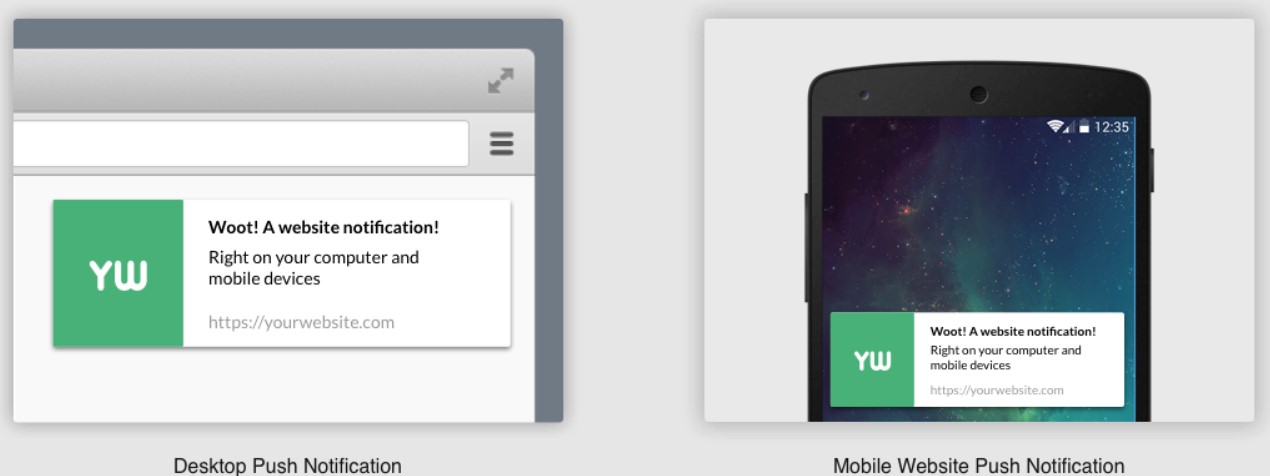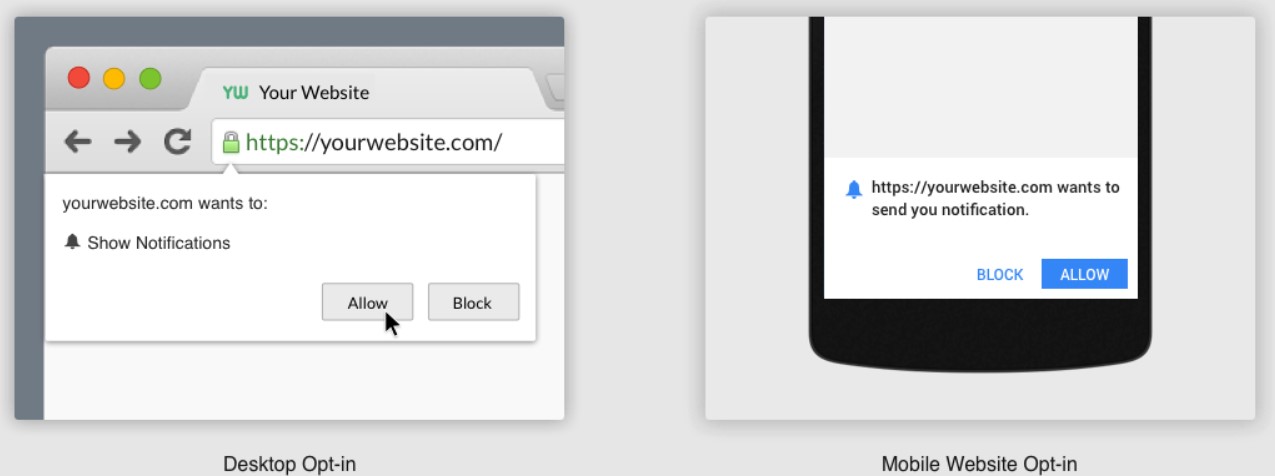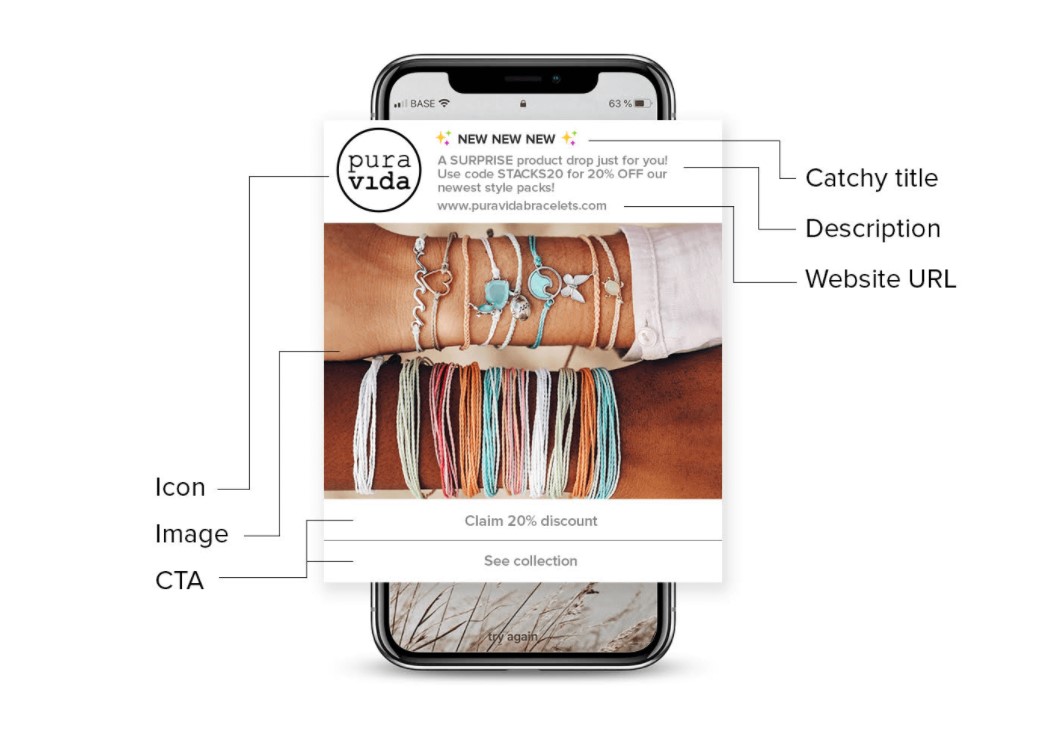Web Push Notifications: Everything You Need to Know
Let’s start with a quick question: What do successful marketing strategies and breakfast share in common?
Answer: The best ones will involve variety.
Think about it. A good breakfast means eating a variety of food - toast, eggs, fruit. You need a variety of food with different nutrients in order to fuel your body and stay healthy.
A healthy marketing plan needs variety, too. To be successful, you need to use various tactics and test strategies to find what works best for your business. You cannot go all in one thing, and one thing only.
So, what should you do to diversify your marketing strategy?
Enter: web push notifications.
Not only do web push notifications let you communicate updates to your audience, but they also enable you to drive traffic to your website or landing page, build your audience, as well as grow your business. Additionally, they can work great in tandem with email marketing.
Read our guide to learn all about web push notifications and how you can use them to complement your own marketing strategy.
What is a web push notification?
Web push notifications, also called desktop notifications or simply push notifications, are short, one-time messages sent right to a subscriber’s desktop when they have a browser open.

Web push notifications are delivered to people who have opted-in to receive messages from one. Once they have opted-in, they don’t need to be on your website to receive push notifications. They often appear in the corner of your desktop or laptop screen and aim to alert your audience of exclusive deals, promotions, offers, or even freebies.
The goal of web push notifications is to drive your audience back to your website or landing page and take any action you want them to do.
How do web push notifications work?
Whenever you install a mobile app, by default, you give the app permission to send you push notifications on your device. However, websites have to explicitly take permission from their users to deliver push messages.
Below is how web push notifications work:
The very first step is getting opt-in from visitors. Once someone arrives on a website, an opt-in is triggered. If they click on “Allow,” they are added to your subscriber list.

When a “visitor” becomes a “subscriber,” you’re allowed to send them push notifications from your website. The title and text message are customizable within particular character limits, and a URL has to be specified. Clicking on the notification will take your subscriber to the URL specified.
Related post:
Differences between web push notifications, in-browser notifications, and mobile push notifications
An in-browser notification is another form of online messaging, which targets active website visitors when they’re actively on your website.
Mobile push notifications, on the other hand, appear on a mobile device. These messages typically go to a user’s phone and show up on a lock screen. When a user opens a push notification, it’ll bring the user to whatever app sent the message. Much like web push notifications, users can actually opt-in and opt-out of receiving notifications.
Web push notifications differ from in-browser and mobile push notifications in that a user doesn’t need to be on the website to receive the push notification. This lets marketers reach users when they are not actively engaging on a website.
Examples of web push notifications
So, what kinds of messages do you send as web push notifications? It depends on what kind of actions you want your users to take.
Here are some typical examples of web push notifications that companies are sending out to boost engagement.
New feature announcements
This is a common way to engage users for SaaS companies. New feature announcements are an excellent way to bring users back to your product. They are also actionable in the sense that users can easily click through and engage with your new feature.
Discounts and offers
E-commerce websites often send targeted and personalized web push notifications for discounts and offers. They are a good way to get customers back to explore your products, especially when you add a time restraint incentive.
SaaS companies can also utilize these to bring back users who may have started their free trial or left a landing page on their site.
New content or products
Blogs and news sites may use push notifications to announce new posts and updates. These can be segmented and personalized to focus on users’ interests for higher engagement. Similarly, E-commerce websites can send segmented and targeted push notifications for new products that customers feel interested in based on their past purchases or engagement on the site.
Updates and bug fixes
Another effective way to engage users with web push notifications is to show users that your team is hard at work to fix issues they are experiencing by letting them know as soon as they’re fixed! It is a great way to show that your customer service is excellent and your team is responsive.
Why do marketers use web push notifications?
Marketers often use web push notifications to build, inform, as well as retain their audience. Push notifications can capture subscribers’ attention, no matter what they are doing online.
Whether someone is in their email box, scrolling social media channels, or browsing their favorite E-commerce sites, if they’re subscribed to opt-in messages, they’ll receive them.
Below are 7 primary reasons why marketers should use web push notifications to elevate their marketing strategy.
#1. They’re easy for web visitors to subscribe (or even unsubscribe)
Opting in for push notifications is as simple as clicking a button - literally.
If someone clicks on “allow,” they’ll start to receive your web push notifications. Likewise, when they no longer wish to receive web push notifications, they can unsubscribe by changing their web browser settings.
This can also remove the barrier of requiring visitors to provide their email addresses.
#2. They allow for instant communication
Promoting your own content can be hard work. There are a number of different social and publishing platforms - but they are not always the best at making sure your content gets seen.
Web push notifications do not depend on social networks. They instantly appear on a subscriber’s browser; thus they can access it immediately.
#3. They are an owned channel
You don’t need to worry that a social media channel will block you from reaching 100% of the people on your list.
But that doesn’t necessarily mean they’ll stay subscribed if you don’t send them valuable content. Therefore, be selective in what you send in order to turn a casual visitor into a regular reader.
#4. They help drive traffic to your website without advertising
Paid ads are an excellent way to drive traffic back to your website. But web push notifications can help you achieve that with your existing audience just as well.
Let your subscribers know when you are running a limited-time sale or having an exclusive offer. No need to spend a lot of money on paid ads to target this group of subscribers - just use web push notifications.
#5. They allow you to build deeper connections with your subscribers
Remember to make your audience a top priority by treating them like a VIP whenever you release new content. Furthermore, sending exclusive content to web push notification subscribers makes them feel valued and a part of your VIP community.
#6. They help grow your audience on other marketing channels
It’s a good idea to leverage your existing email subscriber base to grow your web push notification list and vice versa. Keep in mind to drive them to sign-up pages to grow your email lists and opt-in for notifications.
#7. They can complement a strong email marketing strategy
Web push notifications do not replace email marketing. Email still provides an impressive ROI of any single channel. But not all first-time visitors feel comfortable providing their email addresses.
That’s where push notifications may be the first step in building a relationship.
Combining web push notifications and email can create a winning marketing strategy by giving you additional touchpoints to connect with your audience.
Different elements of a web push notification
Each push notification includes 6 essential elements:
- Notification title
- Notification description
- Notification URL
- Notification icon
- Banner image
- Call-to-action button
It is essential to note that the last two features are available on Chrome.

Below is a detailed breakdown:
-
Notification title. Many brands choose only to put their names here. However, a catchy title to grab attention will probably be more effective.
-
Notification description. Although web push notification character count varies from browser to browser, the rule is simple - the shorter, the better. Remember that your copy should catch the subscriber’s eye and hook their interest.
-
Notification URL. This is the web domain that sent the notification. For example, our website domain is avada.io, that’s also the notification URL.
-
Notification icon. You can choose to place your brand logo or an image here. The default icon for this is often a bell. It’s a good idea to insert your brand logo as it’ll help you distinguish your message from the barrage of notifications your subscribers receive daily. It also means that you don’t have to write your brand name in the title, freeing up characters for a more captivating message. We recommend your icon should be 100x100px and less than 20kb in size.
-
Banner image. Images came in with Chrome 56 and above. On top of showing a catchy message, adding a banner image will actually help you generate more clicks. So, it’s vital to take advantage of this feature.
-
CTA button. You can include up to two CTA buttons in a message and use these buttons to trigger a number of actions.
To help you craft an effective web push notification strategy, we’ve compiled 8 best practices. Let’s explore in the next section!
8 best practices for setting up web push notifications
1. Customize your opt-in prompt
Let’s start from the beginning! Before sending anyone a web push notification, you need to get them to opt-in. While you can use the standard opt-in box, we recommend customizing your own prompt to give your potential subscribers an idea of what to expect from your web push notifications.

This is your opportunity to show the value of your push notifications so that your subscribers are more likely to allow your notifications. Will you announce sales, deliver breaking news, or alert of new messages? Clue people in so that they’re better informed when deciding whether or not to opt-in.
2. Use custom segments
Once you have crafted your first web push campaign, the next step is to target your audience! While you can send a push notification to your entire audience, that is actually not a wise choice. Instead, you should take advantage of custom segments to target more specific groups of people.
Your web push platform can track a lot of relevant information that you can use to segment your audience. Segment based on device type, geographic location, page visited, time since the last visit, amount of money spent, and a lot more.
While your entire subscribers share an interest in your brand or website, they’re still a unique mixture of people. Segmenting them allows you to craft more personalized campaigns that are more likely to resonate and result in a click back to your site. Personalization isn’t a passing trend in digital marketing; it is here to stay. So, be sure you make use of it with your web push campaigns!
You may feel interested in:
- STP Marketing Model: Segmentation - Targeting - Positioning Model
- 10 Persuasive Behavioral Segmentation Examples
- 5 Types of Market Segmentation with Examples
3. Create web push notifications based on browser/ device type

Making sure that your message looks presentable is just as essential as what your message actually says. If you are not careful, your headline or body content may get cut off as a result of the device or browser your subscriber is using. Thankfully, this is not something that is out of your control.
Instead, segment your subscribers based on their browser or device type. Slight tweaks to your message can make sure it looks good across all screens and browsers. We recommend placing the most crucial part of your message towards the beginning of your title or body content to ensure that it doesn’t get cut off. You can also send test notifications to make sure it looks exactly how you want it to.
4. Incorporate CTA buttons
One of the most effective ways to measure the success of your web push notifications is by viewing your CTR (click-through rate). And one way to help boost your CTR is by incorporating action buttons.
CTA buttons help in just about any marketing situation, and that includes web push. Giving your audience a specific goal to complete, as well as an easy way to do it, is an excellent way to boost your overall web push effectiveness.
For an E-commerce website, you might have an action button that says “Add to Cart’’ or “Check out Now.” If you’re running a blog, a “Read More” button can help inspire your subscribers to click. This offers them an easy clear path and can really work wonders at improving your CTR.
5. Optimize by user timezone
It may be 2 in the afternoon your time, but that’s likely not the case for all of your audience. To make sure that your web push notifications arrive when you intend for them to, remember to optimize by user timezone. This is an easy and quick way to ensure you’re providing a great user experience for all of your subscribers.

Web push notifications that arrive at the wrong time don’t just feel out of place, they can also be incredibly annoying if arriving at an inconvenient time like super early in the morning or late at night. An annoyed subscriber is likely to decide to unsubscribe from your notifications, and of course, you don’t want that! Avoid any mistakes of this nature by simply optimizing by user timezone.
6. Make use of triggered campaigns
There are two primary types of web push campaigns: manual campaigns and triggered campaigns.
You can build a manual campaign anytime you want. Create your campaign, select the audience, and schedule it. On the other hand, triggered campaigns send as a result of a subscriber’s specific action at your website.
All you need is to create the campaign and specify what the trigger will be. Once set up, it’ll trigger and send automatically whenever a subscriber completes the given action. This could be visiting a specific page at your website, opting into your push notifications, or abandoning their shopping cart, etc. Triggered campaigns are highly relevant to your audience, making them some of the most effective.
7. A/B test your web push notifications
Test different elements of your web push notifications by setting up A/B tests!
A/B testing (or split testing) is proven to be one of the most effective ways to improve things like CTR or conversion rates. Don’t just rely on guesswork when it comes to your web push campaigns - test various headlines, CTA buttons, body text, and more, then see what works best!

A/B testing works best by changing only one element at a time. For instance, test two unique headlines, but keep the rest of your notification the same. If one version performs better, you can be confident it was because of the headline change. If you test different elements at once, you’ll have no way to know which caused the increase in performance.
No matter how well your push notifications perform, there’s always room for improvement. Set up some A/B tests, and you’re sure to increase your campaign effectiveness over time.
8. Track your conversions
Finally, you should absolutely track your conversions that result from your web push campaigns.
For example, if you’re an E-commerce brand, you can track sales that result from a web push campaign. In other cases, you’re able to set up other custom events as your conversion and track how well your web push campaigns perform.
Seeing how many subscribers click your campaigns is helpful, but to really analyze how well they are performing, you need to enable conversion tracking. If you have got a good CTR but a low conversion rate, you may have a problem. Track your conversions and tweak your web push campaigns as needed to boost your conversion rate.
Related topics:
- How to Calculate Conversion Rate of Websites?
- 15 Persuasive Writing Techniques to Increase Conversion
6 best web push notification software for you to try
So, to help you quickly run a web push campaign, we’ve compiled 6 best web push notifications softwares for you to try. Let’s dive in!
1. OneSignal
OneSignal is a common push notification tool that can create automatic push notifications, announcements, abandoned cart notifications, and more.
You can quickly set your push prompt to display after a specific number of page views and/ or seconds. That means you don’t have to display the push prompt the moment someone arrives on your site. The platform also offers A/B testing and helpful analytics. You can also segment your subscribers for better targeting.
Pricing plans:
- Free Plan
- Growth Plan: from $9/ month
- Professional Plan: from $99/ month
- Enterprise Plan: custom pricing
Related topic: OneSignal Web Push Review
2. iZooto
iZooto offers real-time push notifications, recurring notifications, as well as scheduled notifications. The platform also allows you to customize push notifications, and you can set up segmentation for more targeted messaging. It also includes A/B testing, key user attributes and interests, timezone-based notifications, and more.
Your initial push prompt will appear when the user scrolls down, after a specific length of time, or after a button click. This helps you increase the percentage of site visitors signing up for push notifications.
Keep in mind that iZooto only works with secure websites, meaning your site needs to be using an SSL certificate.
Pricing plans:
- Rise Plan: $85/ month
- Grow Plan: $250/ month
- Enterprise Plan: custom pricing
3. VWO Engage (PushCrew)
VWO Engage, or PushCrew, has a web push notifications tool that can work on both desktop and mobile.
The platform is designed to let you build push notification campaigns, which have entry and exit triggers. That means your campaign can automatically start based on the subscriber’s action, such as clicking a specific link. Subscribers can also be automatically opted out of your campaign when they take a set action, like clicking a button or filling out a form.
VWO Engage offers segmentation, A/B testing, and analytics. However, its segmentation tools and engagement campaigns are actually quite limited.
Pricing plans:
- VWO Engage: from $99/ month
- VWO Insights: from $169/ month
- VWO Testing: from $199/ month
- VWO Fullstack: custom pricing
4. Webpushr
Webpushr is straightforward web notification software that supports all popular browsers. It offers a number of different prompt templates that you can customize.
The software makes it simple to transfer subscribers from another platform. Some other features include automatic web push, user segmentation, and HTTP support. Moreover, it is designed to integrate well with WordPress and WooCommerce.
Pricing plans:
- Free Plan
- Individual Plan: $29/ month
- Startup Plan: $49/ month
- Growth Plan: $99/ month
- Enterprise Plan: custom pricing
5. Pushnami
Pushnami offers sleek and unintrusive web push notifications through desktop and mobile browsers, with an easy installation process and options in order to treat your most loyal customers like VIPs.
The software utilizes what they call Pushnomics, its machine learning, to automate much of the message selection and targeting. This allows you to schedule your campaigns and personalize each message, so every customer feels special when they receive your push notification.
Pricing plan: custom pricing
6. PushAlert
Last but not least, PushAlert is an advanced tool that includes a dedicated WordPress plugin. It allows you to send both desktop and mobile push notifications.
The software includes some great features, such as Audience Creator, which enables you to send notifications to the most relevant and engaged subscribers.
Pricing plans:
- Free Plan
- Basic Plan: $12/ month
- Premium Plan: $39/ month
- Platinum Plan: $69/ month
- Enterprise Plan: custom pricing
The bottom line
That’s it for this web push notification guide!
You can see that using web push notifications can bring back numerous benefits for your campaigns. We hope this guide has helped you a lot! Please contact us if you have any concerns or questions about web push notifications. We’re always willing to help you!
New Posts






